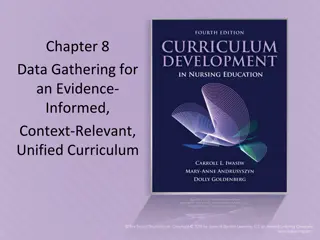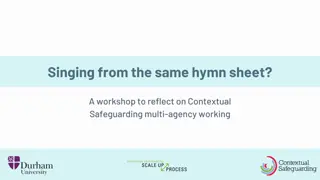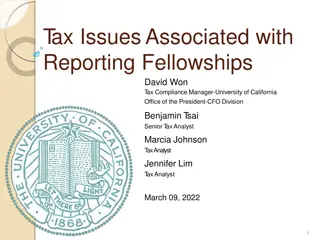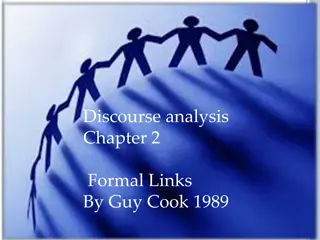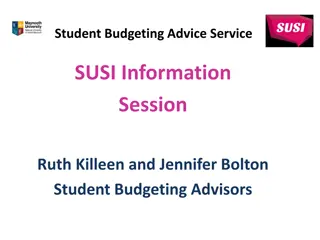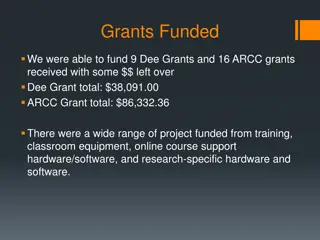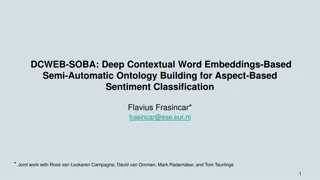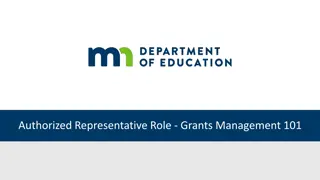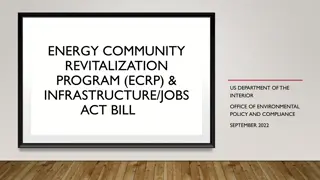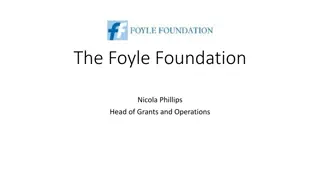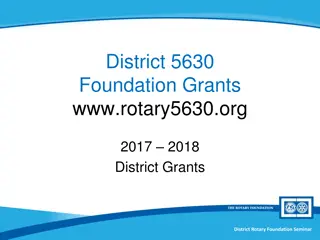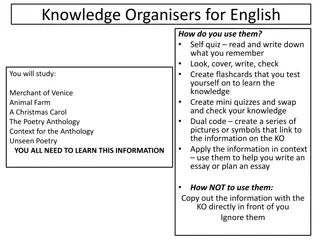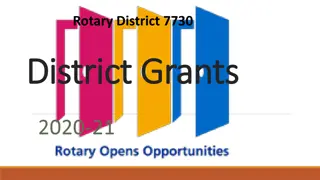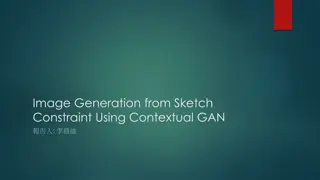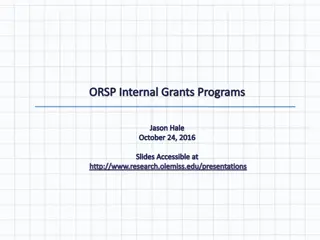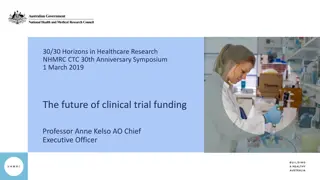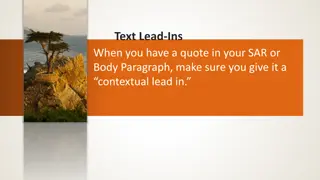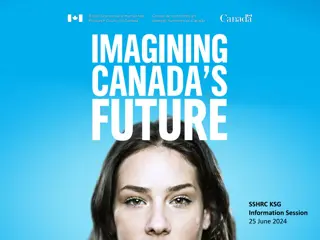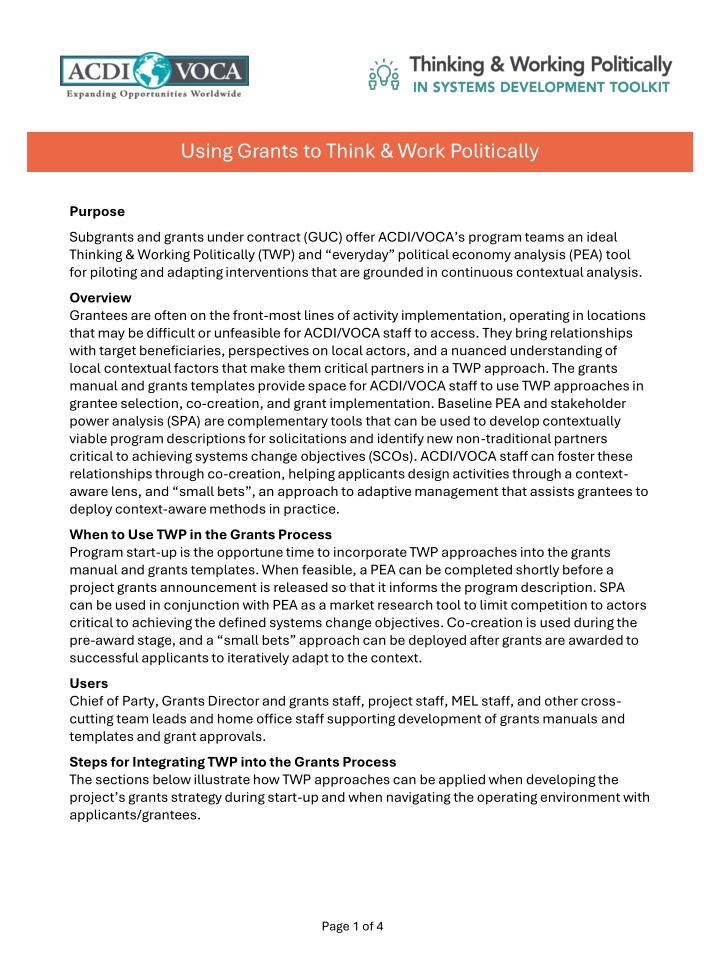
Using Grants Strategically for Contextual Analysis
Create a grants strategy incorporating Thinking & Working Politically (TWP) and Political Economy Analysis (PEA). Integrate TWP tools in grant processes, engage grantees in co-creating activities, and adapt interventions to local contexts. Utilize PEA and Stakeholder Power Analysis (SPA) for effective program design and partnership identification. Implement a context-aware approach through collaborative decision-making with grantees. Enhance grant manuals and templates with TWP methodologies to achieve systems change objectives efficiently.
Uploaded on | 0 Views
Download Presentation

Please find below an Image/Link to download the presentation.
The content on the website is provided AS IS for your information and personal use only. It may not be sold, licensed, or shared on other websites without obtaining consent from the author. If you encounter any issues during the download, it is possible that the publisher has removed the file from their server.
You are allowed to download the files provided on this website for personal or commercial use, subject to the condition that they are used lawfully. All files are the property of their respective owners.
The content on the website is provided AS IS for your information and personal use only. It may not be sold, licensed, or shared on other websites without obtaining consent from the author.
E N D
Presentation Transcript
Using Grants to Think & Work Politically Purpose Subgrants and grants under contract (GUC) offer ACDI/VOCA s program teams an ideal Thinking & Working Politically (TWP) and everyday political economy analysis (PEA) tool for piloting and adapting interventions that are grounded in continuous contextual analysis. Overview Grantees are often on the front-most lines of activity implementation, operating in locations that may be difficult or unfeasible for ACDI/VOCA staff to access. They bring relationships with target beneficiaries, perspectives on local actors, and a nuanced understanding of local contextual factors that make them critical partners in a TWP approach. The grants manual and grants templates provide space for ACDI/VOCA staff to use TWP approaches in grantee selection, co-creation, and grant implementation. Baseline PEA and stakeholder power analysis (SPA) are complementary tools that can be used to develop contextually viable program descriptions for solicitations and identify new non-traditional partners critical to achieving systems change objectives (SCOs). ACDI/VOCA staff can foster these relationships through co-creation, helping applicants design activities through a context- aware lens, and small bets , an approach to adaptive management that assists grantees to deploy context-aware methods in practice. When to Use TWP in the Grants Process Program start-up is the opportune time to incorporate TWP approaches into the grants manual and grants templates. When feasible, a PEA can be completed shortly before a project grants announcement is released so that it informs the program description. SPA can be used in conjunction with PEA as a market research tool to limit competition to actors critical to achieving the defined systems change objectives. Co-creation is used during the pre-award stage, and a small bets approach can be deployed after grants are awarded to successful applicants to iteratively adapt to the context. Users Chief of Party, Grants Director and grants staff, project staff, MEL staff, and other cross- cutting team leads and home office staff supporting development of grants manuals and templates and grant approvals. Steps for Integrating TWP into the Grants Process The sections below illustrate how TWP approaches can be applied when developing the project s grants strategy during start-up and when navigating the operating environment with applicants/grantees. Page 1 of 4
Using Grants to Think & Work Politically Grants Strategy 1. Create adequate space for TWP/PEA in the grants manual and grants template For USAID grant programs, ensure all Restricted and Unrestricted Eligibility options defined in ADS 303.3.6.5 are included as options, particularly ADS 303.3.6.5.d, Restricted Eligibility Based on Programmatic Purposes. The latter provides programmatic rationale for using baseline PEA and SPA findings as market research to justify limiting competition to a select group of applicants. Incorporate language permitting the use of brief (e.g., 2-page) Expressions of Interest (EOIs) in restricted and unrestricted grant announcements. This supports co-creation with key actors identified through SPA and reduces administrative burden for potential applicants and ACDI/VOCA staff, allowing them to have a preliminary discussion regarding potential ways to collaborate prior to submission and review of a concept or full application. Incorporate language requiring applicants who submit an EOI to engage in co-creation with ACDI/VOCA staff before and after concept submission. This provides space for applicants and ACDI/VOCA staff to scenario plan and co-design activities informed by PEA and everyday PEA learnings and recommendations throughout the remaining steps of the pre-award process. In low-capacity environments, consider removing the requirement for applicants to submit a full application after their concept is approved. Instead, allow ACDI/VOCA staff to finalize the program description for the grant agreement with input from applicants during final negotiations. If standard evaluation criteria need to be included in the grants manual, consider including one criterion that speaks specifically to the use of context-aware methods and adaptive management. This will incentivize applicants to propose such methods in their concepts, which can be refined with ACDI/VOCA staff during co-creation and deployed during grant implementation to help ACDI/VOCA programs and grantees iteratively adapt to contextual factors that influence SCOs. Such methods are applicable in all development contexts, including the most stable environments, as each has some degree of fluidity influenced by political factors (e.g., a change in leadership at a key Ministry the program is working with) and economic factors (e.g., external shocks like COVID-19 or supply chain blockages) that require a flexible mindset to navigate successfully. For calls for applications templates, consider including instructions in the technical approach section of the application templates for an Annual Program Statement (APS) and Request for Applications (RFAs) that provide clear guidance to applicants on the importance of proposing context-aware methods for analyzing and adapting to local dynamics (e.g., foundational factors, formal and informal rules of the game , and here and now events). Page 2 of 4
Using Grants to Think & Work Politically Pre-Solicitation / Pre-Award 2. Develop notices of funding opportunities (NOFO) that are informed by PEAs. To the extent practical, time the development and release of APSs to coincide with the completion of baseline and follow-on PEAs to ensure their findings and recommendations are factored into the program description and guidance to applicants. (Note: RFAs are valuable for very specific program requirements; however, because applications cannot be accepted on a rolling basis, they are discouraged as an applied PEA tool. Open-ended APSs, which use modifications to define nuanced requirements/SCOs under multiple rounds of awards, are another option. They are more flexible than RFAs because concepts can be solicitated instead of full applications as an initial step. However, each round is timebound, removing the option to accept concepts on a rolling basis, especially when a new window of opportunity arises in the operating environment.) Consider limiting competition to key actors identified on a rolling basis through SPA (and subsequent SPA updates), which will serve as market research justifying eligibility. If an SPA is not feasible and/or too little is known about the market for potential applicants, full and open competition may be the best option. If the number of likely applicants identified through SPA is low, consider soliciting brief 3- to 4-page concepts and due diligence documents as the entry point for co- creation and determining eligibility. Otherwise, if a high number of applicants is anticipated (or if full and open competition is mandatory), use a simple EOI (e.g., 2 pages) to expedite the initial review/co-creation process and shortlist applicants eligible for a second round of co-creation and due diligence. In both cases, define word limits for each section of the application to encourage focused responses. Ensure technical staff participating in co-creation and evaluation of EOIs/concepts are well versed in the latest contextual learnings (e.g., most recent PEA findings) and factoring them into the selection process. Ensure EOIs and/or concepts are evaluated against the criteria in the NOFO informed by the results of the baseline/follow-on PEA. To help foster collective action, identify opportunities for collaboration and partnerships between applicants/key actors during the evaluation process. Grant Implementation 3. Co-create grant agreements through a context-aware/applied PEA lens. For each apparently successful applicant with an approved concept, assign one technical staff to lead development of the grant agreement. To this end, the technical lead can: Organize one or more design session(s) with the applicant to negotiate and write the final program description. This is an opportune time to scenario plan with the applicant and align activities with the latest contextual learnings/PEA findings and recommendations. Cross-cutting leads (e.g., MEL and GYSI) are also encouraged to participate and provide guidance. Page 3 of 4
Using Grants to Think & Work Politically Support the MEL lead to develop the MEL plan for the grant, ensuring context aware methods and indicators are factored into its design. Include other cross-cutting leads (e.g., GYSI) as applicable in this process. For fixed amount awards (FAAs), support the grants lead to develop the milestone schedule, ensuring it builds in adequate flexibility for context monitoring and adaptive management. To this end, consider the following small bets approach to milestone development: For the first milestone, the grantee can co-create activities with local actors that build on their aligned incentives and existing strengths/assets. A small, fixed amount of funding (e.g., $5,000) would be reserved for the second milestone to pilot these activities. In this scenario, the grantee would develop a simple activity implementation plan demonstrating how it will use this small pool of funds to pilot activities. Simple means of verification (MOVs) would be incorporated into the plan, which ACDI/VOCA would use to justify Milestone 2 completion and payment. For the third milestone, the grantee and ACDI/VOCA staff would analyze the piloted activities demonstrated viability then co-create new activities with local actors to be piloted with a second small pool of funds under the fourth milestone. The grantee would develop another simple implementation plan with MOVs to allow ACDI/VOCA to verify Milestone 4 completion/payment. For the final milestone, the grantee would submit a final report and/or participate in a rapid after-action review (RAAR) with ACDI/VOCA staff to reflect on activities and recommend how to take viable activities to scale. Prior to grant signature, the final program description, MEL plan, and milestone schedule should be reviewed and approved by the Chief of Party (or her/his designee) to ensure the language aligns with the program s overall applied PEA approach and/or latest contextual learnings at the program level. 4. Use grants to continuously monitor and adapt to political economy dynamics. Consider using TWP journaling to support context monitoring and analyze new PE dynamics identified during meetings with grantees and site visits to observe grant activities. TWP journaling can be performed by technical, MEL, and/or grants staff. Consider using RAARs to pause and reflect with grantees on contextual factors influencing activity implementation. RAARs can be included as MOVs for milestones (e.g., at the midpoint and endpoint of activity implementation) and/or factored into the grant s MEL plan. Involve program and MEL staff assigned to the grantee in the review of milestones to ensure new PE-related data obtained from grantees is triangulated against TWP journal entries. This guidance was developed for ACDI/VOCA s internal use through a consultancy with Adapt Consulting. For any questions, contact Ydun Donahoe. Page 4 of 4

